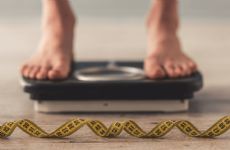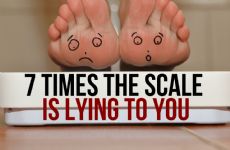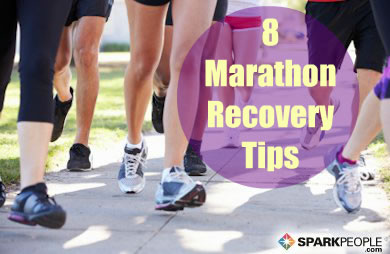|
Love handles, muffin top, spare tire—whatever you call it, extra weight around the waistline is one of the most common trouble zones for those who are overweight or obese. And even people who are already at a healthy weight may tend to carry more fat in the abdominal area. While most are primarily concerned with the physical appearance of their midsections, there are also some serious health concerns linked to excess belly fat. Lauren Popeck, registered dietitian at Orlando Health, says that abdominal fat can pose a significant health risk. "There are two types of belly fat: subcutaneous fat below the skin and visceral fat around the vital organs,” she notes. “Visceral fat poses the highest risk because it actually produces inflammatory compounds, which can increase LDL cholesterol, triglycerides and insulin resistance." According to information from Harvard Medical School, visceral fat cells are dangerous because they release fatty acids directly into the liver, and can also build up in the heart, pancreas and other organs. This excess fat can prevent organs from functioning properly, leading to a higher risk of heart disease, elevated blood sugar and high cholesterol. That means slimming down your waistline won’t just achieve aesthetic results, but could also help you live a healthier life. That said, it’s important to remember that it’s not possible to "spot reduce" specific areas of the body. Just as you can’t squat your way to a perfect rear end, all the crunches in the world won’t make your belly flatter—although they will strengthen the underlying muscles. The key is overall fat loss, which will showcase the muscles you’ve worked so hard to develop. “Although you can target specific parts of the body to gain muscle and strength (like when you do a chest press that works your chest muscles), the same isn’t true for fat loss,” Coach Jen points out. “Your body decides for itself where and when it wants to take the fat off, so crunches aren’t going to help you lose belly fat and leg lifts won’t make your thighs smaller. Eventually, through a healthy diet and regular exercise, you’ll lose fat in the areas where you carry excess. You just have to be patient, because it might not happen in the places you want at the rate you’d expect.” But don’t throw in the towel and resign yourself to life with love handles just yet. Although you can’t bust belly fat with targeted exercises, there are some things you can do to help strengthen your stomach, reduce bloating and accelerate overall fat loss, all of which will help you create a slimmer, stronger abdomen. 1. Limit sodium intake.Sodium is a naturally occurring mineral that we all need—in moderation, of course. Too much sodium can increase the risk of not only high blood pressure and heart disease, but also bloating. Many highly processed foods are high in sodium, so even if you’re not piling on the salt yourself, you could be unknowingly bloating your belly when eating crackers, deli meats, bread, cheese, soups and other sneaky sodium sources. As Coach Jen points out, the recommended limit for sodium is 2,300 milligrams daily, but the average American consumes about 3,300 milligrams per day, not including any additional salt they add to their food. To reduce your sodium intake and cut down on bloating, she suggests looking for low-sodium alternatives and trying to eat a diet lower in processed foods and high in fruits and veggies. 2. Avoid carbonated beverages.Popeck suggests steering clear of bubbly beverages and choosing water, instead. According to WebMD, the carbonation in fizzy drinks can send gas bubbles into your belly, causing bloating and discomfort. This can occur even with zero-calorie drinks. If you don’t like plain water, try adding some freshly cut fruit for natural flavor, or switch to flavored tea. Another perk of upping your water intake is that it will help prevent overeating during meals and curb cravings for unhealthy snacks. 3. Eat smaller and slower.Another way to reduce the size of your stomach, Popeck says, is to stick to sensible portion sizes and eat foods slowly and mindfully. Chew each bite thoroughly and take the time to savor the taste. The end result will be less food volume consumed, which will prevent that uncomfortable swollen feeling that comes with overeating. As a bonus, you’ll also likely cut your calorie intake, which will help to speed up weight loss if that’s your goal. 4. Beef up the probiotics.Probiotics are “friendly” bacteria that help to promote a healthy digestive system. In addition to being linked to a bevy of health benefits—including improved immunity, reduced cholesterol levels and a decreased risk of certain cancers—they’ve also been shown to reduce bloating. Some prospective studies have found that participants who used probiotics “found an improvement in bloating severity” compared to groups who did not use them. According to SparkPeople’s registered dietitian, Becky Hand, some common food sources of probiotics include yogurt, kefir and fermented milk. You can also take probiotic supplements in the form of capsules, liquids or powders, though Hand says it’s important to exercise caution before using a probiotic supplement, as the Food and Drug Administration (FDA) does not regulate them in the same way that it regulates medication. 5. Consider reducing FODMAPs.For her clients who struggle with bloating, Popeck recommends limiting consumption of FODMAPs— Fermentable Oligo-, Di-, Mono-saccharides And Polyols—which are short-chain, indigestible carbohydrates. Instead of being digested, FODMAPs hang out with the gut bacteria, producing gas and bringing liquid into the intestine. According to Healthline, studies have linked FODMAPs to gas, bloating, stomach pain and other digestive issues. FODMAPs may include fructose (found in many fruits, veggies and added sugars), lactose (found in many dairy products), fructans (found in wheat, rye, barley and other gluten grains), galactans (found in legumes) and polyols (sugar alcohols found in some fruits, veggies and sweeteners). Consult this list of foods to eat and avoid on a low-FODMAPs diet. 6. Include core exercises in your routine.As Coach Jen mentioned earlier, you can't spot reduce. However, you can strengthen your core muscles through targeted abdominal exercises. Combined with a healthy diet and fat-burning cardio, core work will help those underlying muscles look their best. While there are hundreds of exercises designed to get those abs burning, personal trainer Rui Li finds Pilates leg lifts to be particularly effective at sculpting the waist and building basic strength in the abdominal area.
 7. Don’t expect a shortcut.Although some of these strategies might help to reduce bloating and make your belly feel smaller, there is no quick fix to shrink your waistline. “Exercise combined with a healthy diet is the best way to reduce overall weight and, in turn, waist circumference,” says Popeck. “Although reducing calories is necessary, in my experience, some patients see results with lower carbs and some do better with lower fat. It’s just a practice of finding what is right for each body and lifestyle.” |
Popular Entries
Related Entries
More From SparkPeople |























